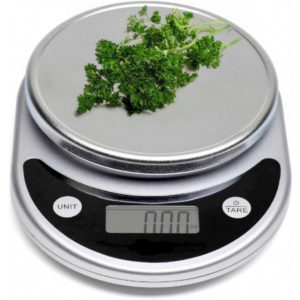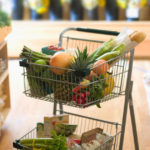 I’ve never owned a kitchen scale in my life, but a company recently sent me one for free when I ordered their immersion blender. (This post isn’t sponsored at all – it’s my own adventures in weighing my food.) Here’s what I learned in the first three days of being able to weigh my food on the fly.
I’ve never owned a kitchen scale in my life, but a company recently sent me one for free when I ordered their immersion blender. (This post isn’t sponsored at all – it’s my own adventures in weighing my food.) Here’s what I learned in the first three days of being able to weigh my food on the fly.
1. I am eating a lot less than I think I am.
Whenever I’m eating something that doesn’t fit well in a measuring cup or spoon, I’ve always used the nutritionists’ standards for eyeballing my portion sizes: a 1″ cube of cheese is 1 ounce, a pack of cards is a 4 ounce serving of meat, etc. If something comes in a weighed package (like hard or semi-soft cheese or deli meat), I divide the contents into the stated number of servings shown on the package. Should work, right?
My 1″ cheese cubes were about 3/4 of an ounce. My 1/4 package of 16 ounces of ground beef was 2.8 ounces, not the 4 I thought it should have been. Even my 1 cup of zucchini, which should be equivalent to 100 grams according to the calculated nutrition, was only 70 grams. All in all, I was short 150 calories out of 328 across just those three foods compared to what I had logged – nearly half! – and that was just one part of one meal.
I’d like to say that those experiences were unique, but for me (especially since I don’t eat a lot of packaged food that comes pre-weighed and pre-portioned), I found that well over half of my estimated portion sizes came up short against the weighed portion sizes, and that I was generally only eating about 3/4 as much as I thought I was throughout a day.
2. Weighing food isn’t that big of a deal.
I thought a food scale was a little bit obsessive for everyday use – and I can’t say that it will become a regular part of my routine (especially since I want to be able to loan it out to my clients so they can fix up their eyeballed portion sizes, too). In practice, it really wasn’t so cumbersome. I used a plate on top of the scale to hold my cheeses, veggies, and cooked meats as I weighed each serving, then used that same plate when eating my meal to avoid double dish-duty.
Compared to that of measuring cups, containers that are pre-measured, and other measurements of food by volume, the accuracy of a food scale far outweighed the twinges of compulsion I felt when weighing my portions.
3. I won’t weigh everything forever.
My ultimate goal with this scale experiment, once I learned that I was undereating (because, like most everyone, I would have guessed the other way around), was to reset my eyeballed portions to their correct sizes. I will still use the scale to check out new or uncertain stuff, especially really nutrient-dense foods like cheeses and nuts, but I don’t think I will stress about eating 20 grams of sliced apple vs 16 – since our bodies don’t perfectly absorb every calorie that we take in, I will find a way to cope with eating the 6 or so calories of variance from apple to apple.
Even though I keep a pretty minimalist kitchen, this scale will stick around for a while – it has already earned its keep for 2017 with what I learned in our first 3 days together, and I can see how it will be useful in both food tracking and recipe development.
4. I would almost recommend a turn with a kitchen scale to everyone.
They’re $10 or $15 on Amazon, and they’re super easy to use – mine only has 2 buttons, and yet I can change easily between ounces and grams (depending on what unit the reference values are in for a given food).
They’re eye-opening about portion sizes in a way that measuring cups just evidently aren’t. After all, 75% accuracy across even a 1600-calorie day means that you could be eating anywhere from 1200 to 2000 calories while thinking you’re getting 1600.
They can teach you a lot about how your portion sizes are going after just a few days of spot measuring, and then you could put the scale away or loan it to a friend for a while and put your new knowledge to use.
They’re also convenient for baking, since most of the rest of the world measures by weight when baking rather than by volume…and now I see why!
However, weighing food does have a bit of a weird over-controlling feeling to it to me, moreso even than using an app to track your food or keeping a photo log of your meals, so if you’ve ever had past issues with food and control (too much or too little control), I wouldn’t recommend using a kitchen scale. I also wouldn’t recommend daily, continued use of a kitchen scale to anyone unless so directed by a doctor or other health professional.
I’m specifically not linking to my scale since it was sent to me for free, but Amazon does have a ton of very affordable kitchen scale options in case I’ve piqued your curiosity.
Remember, there’s a lot that a scale can’t tell you about your food – like how nutritious it is, how much protein it has, or how tasty it will be – so don’t go off the deep end with this one. I was convinced that I would never use or like a kitchen scale, but my first few days with one have been so eye-opening that I wanted to share my experience, but food will never be just a numbers game for anyone!
If you’re already a Tiny Fitness personal training client and you want to borrow the scale for an overnight home visit, just let me know!

